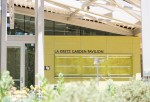More than 300 visitors toured the Mildred E. Mathias Botanical Garden on Tuesday to admire the newly unveiled La Kretz Garden Pavilion, the first in a series of intended improvements to the garden.
Tuesday’s open house featured speeches by Chancellor Gene Block, Peter Raven, a botanist, and Philip Rundel, a professor emeritus of ecology and evolutionary biology. Speakers reminisced about the garden’s 88-year history and said they think the pavilion has a lot of potential as an educational space. Morton La Kretz, the philanthropist and real estate developer who funded the pavilion, also attended the event.
The pavilion will be reserved for class lectures during weekdays and for public gatherings and other entertainment during evenings and weekends.
Rundel, the director of the garden, said the garden also improved wheelchair accessibility, added an adjacent sidewalk and constructed a more prominent entryway at the junction of Tiverton Drive and Charles E. Young Drive.
“The pavilion is just one step that we envision as a whole series of improvements,” said Rundel.
Rundel said he thinks it is necessary to remodel the garden to improve its visibility.
“Before, I’d tell people to meet me in the garden and they wouldn’t know where to go,” Rundel said. “There was also no sidewalk in front of the garden and very little seating.”
He added he thinks the garden’s amphitheater and outdoor classroom, known as the Nest, needs to be upgraded to accommodate more people.
“It’s not comfortable and it can only seat about 50 people,” Rundel said. “We want to upgrade it to accommodate 100 people and add a stage for music events, panels, discussions or poetry readings, while still keeping it rustic.”
Rundel said the garden will contain more informational materials, including additional guided tours and signs, to bolster the garden’s educational experience.
Victoria Sork, dean of life sciences, said she thinks the garden should better highlight the different types of flora it hosts.
“We want to emphasize our plant collections – we have conifers, Southern California plants, desert plants (among others) – and allow people to get more of a story (when they visit the garden),” she said.
Sork said she hopes to raise funding to refurbish the garden’s turtle and koi-filled stream and refine the stream’s water-recycling system.
Sork said she thinks the garden is not well-known because it is not readily visible, which is why future construction plans include refurbishing the Hilgard entrance at the southeast corner of campus.
“We’ll make these changes as we raise money,” Sork said. “Seven years ago, (these recent upgrades) were a dream, and look what happened now.”
Sork said the garden intends to raise at least $25 million in donations to support its future remodeling initiatives.
Sork added that students who take Life Sciences 1: “Evolution, Ecology and Biodiversity” will visit the garden and prepare presentations on its various species. However, Sork said that few other students are aware of the garden.
Maria Kiejnich, a second-year economics student, said she has been visiting the garden at least three times a week ever since she was introduced to it in an ecology class. She said she hopes the garden becomes more visible to the campus community because she thinks it can inspire students from different majors to become more environmentally conscious.
Kiejnich added she thinks the garden should provide ecological learning materials, such as as tips and tricks for how to be eco-friendly and books on nature and the environment.
She added she hopes the garden will improve its visibility by hosting social events, such as concerts, at the new pavilion. She added she thinks campus organizations can use the garden for fundraisers.
“I think the garden will inspire a lot of people to take care of our planet (because) you see so much beautiful diversity, how much happiness nature can bring and how amazingly nature can integrate into urban life,” Kiejnich said.
